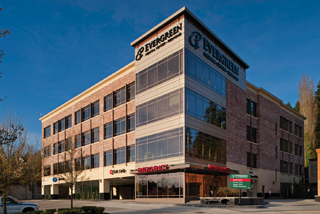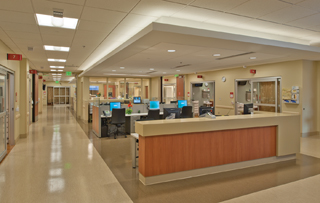|
Subscribe / Renew |
|
|
Contact Us |
|
| ► Subscribe to our Free Weekly Newsletter | |
| home | Welcome, sign in or click here to subscribe. | login |
Construction
| |
 |
June 23, 2011
Evergreen opens center closer to its patients
PSF Mechanical

Tuminello
|
Health care reform is motivating fundamental changes in health care delivery.
We’re now seeing significant efforts to streamline processes and reduce costs while simultaneously improving quality. These are the same chords industries like entertainment and manufacturing have been striking for decades. It’s great to see health care chime in as well.
An outstanding example of this change resides in Redmond. Evergreen Medical Center, a subsidiary of Evergreen Hospital, stands out as an innovative prototype for the future. Located in the Bella Bottega Shopping Center — a setting you would not normally envision with its various stores, restaurants and a movie theater — this 24/7 medical facility brings everything but the most acute capabilities right to residents’ doorsteps.
Developed as a build-to-suit by Bella Bottega LLC (a partnership formed by Gary Merlino Development), Evergreen Medical Center is a three-story, 48,000-square-foot primary, urgent and emergency care facility. It houses a Level III trauma center, full-scale analytic laboratory, comprehensive diagnostic imaging, and offers 24-hour outpatient emergency and surgical services.
Like a living room
Evergreen Medical Center represents the growing trend of moving major medical services downstream from main hospital campuses to locations more integrated within the community.
Ask a few patrons what they think about Evergreen’s new facility and you’ll hear comments like, “It’s really convenient — I don’t have to traipse all over town going to a bunch of different doctors, they’re all right here,” and, “You go inside and it just doesn’t seem like a doctor’s office — it’s like I’m sitting in my own living room!”
Jamey Barlet, project architect for CollinsWoerman, said, “We wanted to change the way patients think about a trip to the doctor’s office. At Evergreen, we made extensive use of natural light, warm colors, soft lighting, and integrated natural materials like wood and stone to create a more relaxed environment.”
The result is a facility that really does feel more like your living room and less like a cold, sterile examination space.
Evergreen is making a strong emotional connection to the community with this facility, but there’s a pragmatic side as well. Medical costs per square foot are much less at this location than comparable services at the main campus.
The synergy created by multiple primary practices operating under one roof with access to diagnostic imaging and lab tools creates greater operational efficiency. All combined, these results are akin to a medical services triple play.
Lessons from Disney
Talk to any health care CEO today about his or her top priorities and you’ll hear comments similar to this one from Jim Leonard:
“We knew we had to rethink our traditions and look outside ourselves to other industries for help. We had to enhance the ‘patient experience,’ which we learned from Disney, and improve operations using the ‘lean’ techniques we got from Toyota.”
Phil Giuntoli, health care design principal at CollinsWoerman, spoke of the Disney experience as a primary driver behind their approach.
“A key factor in our design is a concept Disney refers to as ‘on stage, off stage,’” he said.
“At Disneyland, you never see any of the offstage production in front of you, and the same is true for Evergreen. We placed a ‘core services area’ in the center with patient exam rooms flanked on both sides. Because patient and staff access into exam areas occurs on opposite ends of the room, patients never see what goes on behind the scenes in the core where meds are prepared, supplies stored, and where doctors and nurses carry on diagnostic conversations.
“All of this is done discretely out of sight with no distraction to the patient. It makes the whole patient experience more pleasant and less intimidating.”
While a building’s aesthetics and functional spaces are essential, the building systems that support them are critical. Nowhere is this relationship more important than in a health care facility.
When asked about the interdependence between a building’s architecture and its mechanical and electrical systems, Barlet said, “As architects, we rely heavily on our consultants and construction partners like PSF Mechanical. We can create wonderful spaces that achieve every aesthetic and functional requirement, but if the spaces are too hot or too cold, people leave. And in a health care environment where there are daily life-and-death situations, a med gas line better work!”
Like Disney’s “on stage, offstage” approach, a lot of technical work behind the scenes transpired to ensure Evergreen’s successful design and construction. Extensive use of 3-D building-information modeling (BIM) was employed to optimize the design and improve construction labor efficiency.
“Intensive use of BIM MEP (mechanical, electrical and plumbing) and a sleeves-rolled-up approach to coordination in the field played an instrumental role in providing such a beautiful and functional space to serve this community,” said Andrea Hovey, project manager for PSF Mechanical.
Community relations
“The relationship between the customer, construction team and the community begins well before ribbons are cut — it starts at the project’s inception,” said Wilf Wainhouse, COO for Sellen Construction.
He continued: “Community relations is not something a client typically expects from their construction teams, but when you’re working on a site as tight as Evergreen’s, things like site control, thoughtful material staging, work scheduling, signage, and especially, safe pedestrian access around the job site are critical. It means businesses can stay open and profitable and residents can access the center and the services they’ve come to rely on without interruption.”
A recent email from our client Ty Heim, construction manager for Evergreen, put the whole project into perspective:
“A few days ago, an ambulance in route to the hospital with a critically ill patient had to be rerouted to our closer Redmond (emergency department) facility when they realized the patient might not make it. After hours of intensive care, he was stabilized sufficiently to be transported back to the main campus.
“The final outcome was good and another life was saved. I don’t know that we ever said thank you adequately enough for all your hard work, but I do hope this example speaks volumes in far more human terms than a simple ‘thank you’ could ever fully express.”
Randy Tuminello is a senior vice president with PSF Mechanical, a local mechanical engineering, construction and consulting firm based in Seattle.
Other Stories:
- 13 tips for choosing your medical space
- Study will help UW’s Montlake Tower cut energy costs
- Swedish Issaquah aligns design with patient needs
- Good signage points the way to better health care
- 'Novel' process lets Swedish Issaquah hit fast forward
- ‘Hybrid’ rooms a low-cost answer to space needs
- Swedish women’s cancer center a one-stop shop
- Group Health is designing its clinic of the future
- Puyallup hospital tower puts focus on patients
- New VA complex to treat ‘emerging’ war injuries
- Friday Harbor hospital aims to be nation’s greenest
- UW expansion stays on track despite big change in plans




